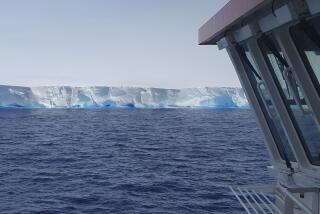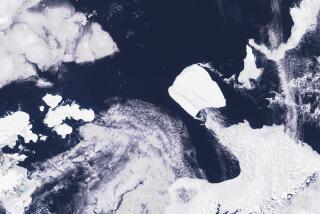ANTARCTICA : Huge Iceberg Poses a Threat to Shipping : Measuring about 55 by 35 miles, it’s creeping north toward the Falklands and into major sea lanes.
- Share via
LONDON — A massive iceberg that once bulked larger than Long Island is inching northward toward the South Atlantic Ocean and threatening shipping lanes between South America and Africa.
Known officially as A-24 (the A is for Atlantic), the iceberg originally measured 70 miles by 50 miles when it broke off the Antarctic ice shelf in 1986.
It hovered close to home in the Weddell Sea, moving up the Antarctic Peninsula, until earlier this year when it drifted into the northbound Antarctic Current that took it toward the South Atlantic Ocean.
The British Antarctic Survey, monitoring the iceberg by satellite, has called for a 50-mile exclusion zone around it to protect shipping.
LOCATION: The massive, 100-billion-ton block of ice, now measuring about 55 by 35 miles, is now heading north at a few miles a day toward the passage between the Falkland Islands and South Georgia Island, several hundred miles east of the southern tip of Argentina, according to Robert Headland, curator of the Scott Polar Research Institute in Cambridge, England. It is now about 300 miles east-southeast of the Falklands.
Headland noted that the waters near Antarctica are very cold, slowing the iceberg’s melting.
“But parts of the iceberg have hived off, presenting problems for the East European, Taiwanese and Korean fishing trawlers operating in the area,” he said. “They are often rust-buckets with limited radar.
“The problems and danger will increase as the iceberg moves up into the warmer South Atlantic Ocean and begins to split up. Then these ‘bergie bits’ will pose a real hazard to larger ships navigating around Cape Horn or the Cape of Good Hope.”
Sea lanes run northward from the east coast of South America to North America and Europe and eastward to Africa. Large tanker routes from the Mideast go around southern Africa and through the South Atlantic.
COMPLICATIONS: The problem is compounded, Headland notes, by the fact that the enormous floating mass, which rises in a 200-foot cliff, tends to create its own weather around it.
“The differential between the much lower temperature of A-24 and the sea around it--a degree above freezing--creates nasty weather: fog and mist which make it hard to see from the ocean and from satellites.”
Two years ago, the Soviet cruise ship Maxim Gorky rammed an iceberg in Arctic waters, stranding 600 passengers. A Norwegian rescue ship finally broke through and rescued those aboard.
In 1912, the liner Titanic, on its maiden voyage, hit an iceberg and sank in the North Atlantic, with the loss of 1,513 lives.
Aboard the massive iceberg, the largest ever regularly tracked, is the former Antarctic Shackleton Station used by British explorer Sir Vivian Fuchs, who led the Commonwealth Trans-Antarctic Expedition that crossed the continent by tractor in 1957-58, traveling more than 2,100 miles to Scott Base in 99 days.
Shackleton Station, abandoned long ago, was lost when a huge chunk of the Filchner Ice Shelf broke off, creating A-24.
The iceberg’s only passengers are a bunch of hitchhiking penguins.
“The penguins will be OK even when the ice eventually melts,” observed Headland, who believes the major part of the iceberg could survive for up to four more months.
“They are good swimmers and there’s lots of food in the ocean. They might even end up on South Georgia or the Falklands.
“So you might say they are not being kidnaped but are only being relocated.”
More to Read
Sign up for Essential California
The most important California stories and recommendations in your inbox every morning.
You may occasionally receive promotional content from the Los Angeles Times.










